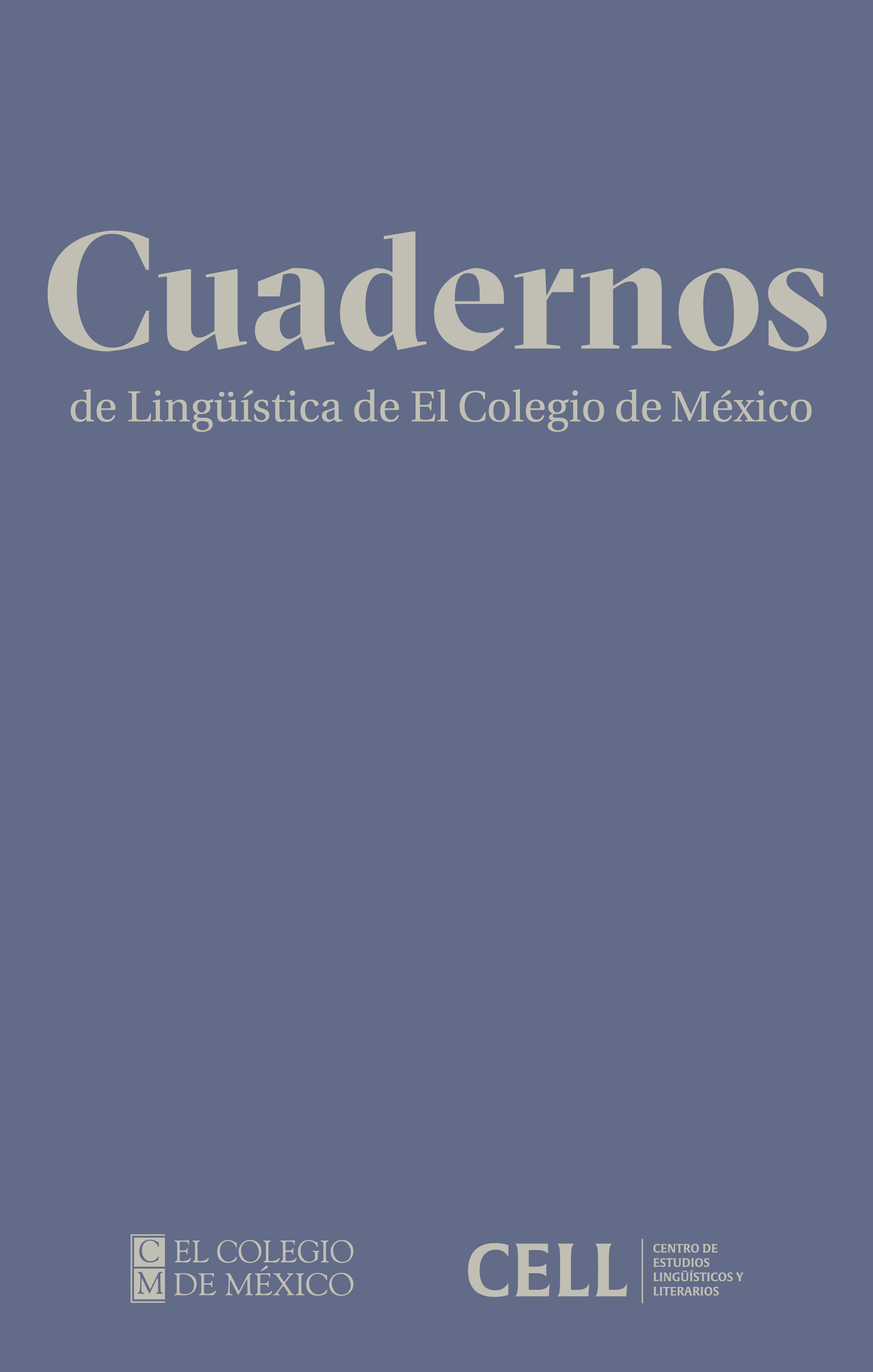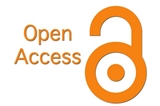Imperativos y otras expresiones directivas en el p’urhepecha de Ihuatzio
DOI:
https://doi.org/10.24201/clecm.v11i00.314Keywords:
non-canonical imperatives, yusive, exhorative, commands, mood, Tarascan grammar, Mexican indigenous languagesAbstract
This paper is a descriptive study of the imperatives in P’urhepecha language of the community of Ihuatzio. Although the imperative and prohibitive (or vedative) for the second person singular and plural are described in all reference grammars of P’urhepecha (Foster 1969; Wares 1974; de Wolf 1989; Chamoreau 2009), there has been little discussion of the existence of non-canonical imperatives in the language, that is, those of the first and third person singular and plural (Aikhenvald 2010, 2017). The present paper provides evidence for the existence of these non-canonical imperatives in this language and demonstrates the complexity of this category that had generally deserved little attention. Additionally, some nuances of meaning with auxiliary verbs will be accounted for, as well as some other ways of expressing directives in the language.
Downloads
References
Adelaar, Willem. 2017. Imperatives and commands in Quechua. En Aik- henvald, Alexandra & Dixon, M. R. W (eds.), Commands. A cross-linguistic typology, 46-60. Oxford: Oxford University Press. https://doi. org/10.1093/oso/9780198803225.003.0002 DOI: https://doi.org/10.1093/oso/9780198803225.003.0002
Aikhenvald, Alexandra. 2010. Imperatives and commands. Oxford: Oxford University Press.
Aikhenvald, Alexandra. 2017. Imperatives and commands: a cross-linguistic view. En Aikhenvald, Alexandra & Dixon, M. R. W (eds.), Commands. A cross-linguistic typology, 1-45. Oxford: Oxford University Press. https://doi.org/10.1093/oso/9780198803225.003.0001 DOI: https://doi.org/10.1093/oso/9780198803225.003.0001
Capistrán, Alejandra. 2002. Variación de orden de constituyentes en p’orhépecha. Topicalización y focalización. En Paulette Levy (ed.), Del cora al maya yucateco, estudios lingüísticos sobre algunas lenguas indígenas mexicanas, 349-402. México: UNAM.
Capistrán Garza B., Alejandra & Lucas Hernández, Puki. 2016. El p’orhépecha de Santa Fe de la Laguna. Un asomo a la variación dialectal en tres estructuras gramático-discursivas. En Martínez, Roberto; Espejel, Claudia & Villavicencio, Frida (eds.) Unidad y variación cultural en Michoacán. 199-223. México: El Colegio de Michoacán/ IIH-UNAM.
Castilleja González, Aída & Argueta Villamar, Arturo. 2018. Los P’urhepecha, un pueblo renaciente. México: UNAM/ Centro Regional de Investigaciones Multidisciplinarias/ Juan Pablos Editor.
Chamoreau, Claudine. 2004. El encuentro del tabardillo. Introducción a algunos procesos narrativos en purépecha. Tlalocan 14. 95-131. https://libros.crim.unam.mx/index.php/lc/catalog/view/284/184/677-1 DOI: https://doi.org/10.19130/iifl.tlalocan.2004.173
Chamoreau, Claudine. 2009. Wantee p’urhépecha. Hablemos p’urhepecha. Morelia: UIIM/Grupo Kw’aniskuyarhani de Estudiosos del Pueblo Purépecha/Instituto de Investigaciones Históricas/Morevallado.
Chamoreau, Claudine. 2014. Enclitics in Purepecha: variation and split localization. En Léonard, Jean Léo & Kihm, Alain (eds). Patterns in MesoAmerican morphology. 119-143. París: Michel Houdiard.
Colectivo Anhatapu. 2016. Juchari echerio. Miiuntskani ka Miiuntaskuarhintani Juchari Echerirhu. México: Concejo Mayor y Consejo de los Bienes Comunales de Cheran K’eri /Espacio para la Cultura Ambiental, A.C/Red Temática sobre el Patrimonio Biocultural, CONACYT.
Centro de Cooperación Regional para la Educación de Adultos en América Latina y el Caribe (CREFAL) ca. 1987. Uandanskuecha ka arhinstkateacha purhepecha jimpo. Cuentos y leyendas purépechas. Pátzcuaro: CREFAL.
de Wolf, Paul. 1989. Seis estudios lingüísticos sobre la lengua phorhé. Zamora: El Colegio de Michoacán/Gobierno del Estado de Michoacán.
Foster, Mary. 1969. The tarascan language. Berkeley: University of California Press. Glosbe. Diccionario purépecha-español. https://es.glosbe.com/tsz/es
Hernández Domínguez, Rolando. 2015. Na-kani-ne jucha anapu jimpo. Aspecto, tiempo, modalidad y modo en purépecha. México: CIESAS. (Tesis de doctorado.)
Herrera Castro, Samuel. 2013. Cláusulas relativas en el purépecha de Carapan, Michoacán. Cuadernos de Lingüística de El Colegio de México 1. 26-55.
Instituto Nacional de Estadística y Geografía (INEGI). 2020. Censo general de población y vivienda 2020. México: INEGI. https://censo2020.mx/
Lagunas, Juan Baptista de. 1983 [1574]. Arte y Dictionario con Otras Obras en Lengua Michuacana. Edición de Benedict Warren. Morelia: Fimax.
Lucas Hernández, Puki. 2018. Sistema de evidenciales en la lengua p’ur- hepecha en la comunidad de Santa Fe de la Laguna. México: CIESAS. (Tesis de maestría.)
Mendoza, Martha. 2016. Politeness strategies in a Mesoamerican language isolate: the case of P’urhepecha. LIAMES 16(1). 139-156. DOI: https://doi.org/10.20396/liames.v16i1.8646170
Meneses Eternod, Sue & García Marcelino, Ismael. 2018. Ju je uantani. Manual para la enseñanza de la lengua p’urhepecha. Morelia: UNAM/ Laboratorio Nacional de Materiales Orales.
Meneses Hernández, Luis David. 2013. Sistema de demostrativos en el purépecha de Carapan, Michoacán. Cuadernos de Lingüística de El Colegio de México 1. 206-234.
Monzón, Cristina. 2021. La construcción de la palabra purépecha. Vol. 1. México: El Colegio de Michoacán.
Nicolás Reyes, Gerardo. 2024. Las cláusulas relativas en el p’urhépecha de Comachuén, Michoacán. México: CIESAS. (Tesis de maestría.) CONACULTA-Dirección General de Culturas Populares. 1997. P’urhépecha uantantskuecha. México: CONACULTA. Lenguas de México 12.
Torres Sánchez, Joel. 2001. P’urhepecha uandantskuecha. Narrativa p’urhepecha, vol. 2. Morelia: Secretaría de Educación del Estado.
Villavicencio Zarza, Frida. 2014. Modalidad y cortesía en la lengua de Michoacán. En Martín Butragueño, Pedro & Orozco, Leonor. Argumentos cuantitativos y cualitativos en sociolingüística: Segundo coloquio de cambio y variación lingüística. 761-781. México: El Colegio de México. DOI: https://doi.org/10.2307/j.ctv6jmww1.32
Wares, Alan. 1974. Tarascan verb inflection. SIL-Mexico Workpapers 1. 93-100.
Published
How to Cite
-
Abstract338
-
PDF (Español)169
-
XML (Español)7
-
EPUB (Español)11
-
Kindle (Español)39
-
MP3 (Español)2
Issue
Section
License
Copyright (c) 2025 Sue Meneses Eternod

This work is licensed under a Creative Commons Attribution-NonCommercial 4.0 International License.
Authors retain copyright of their work and are free to disseminate it, make copies for any use, and/or deposit in any repository or archive of their choice, but they grant Cuadernos de Lingüística de El Colegio de México the right to publish the work for the first time. Authors agree to acknowledge Cuadernos de Lingüística de El Colegio de México as the site of original publication of their article / note / review through proper citation.
Articles appearing in Cuadernos de Lingüística de El Colegio de México are made available to readers under a Attribution-NonCommercial-NoDerivatives 4.0 International.









